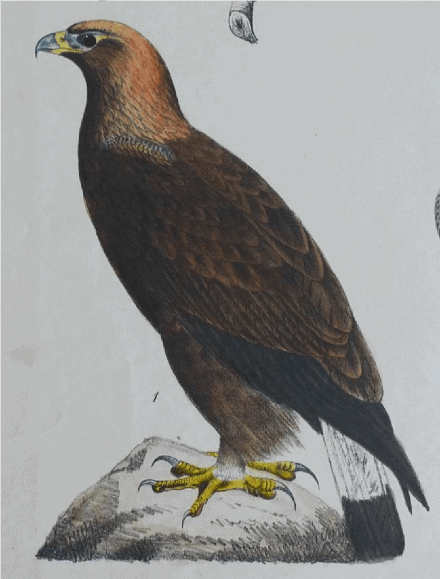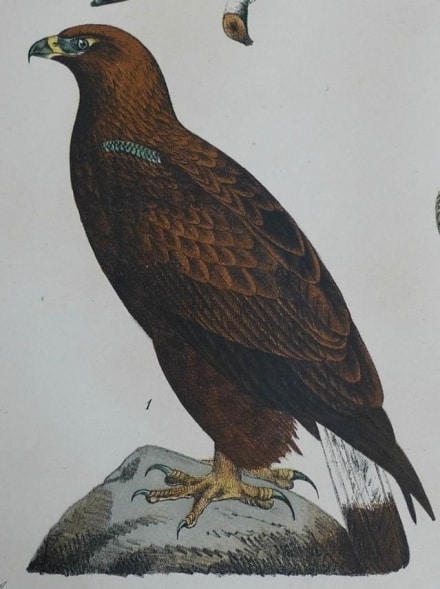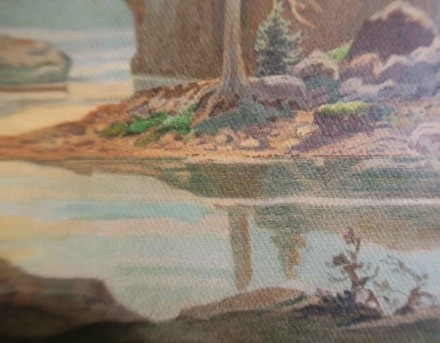Jan af Burén
Chromolithography in Sweden in the 19th century
Text of a paper given by Jan af Burén at the conference of the Association of European Printing Museums, From stone to chip: Alois Senefelder and the invention of printing in an international context, Nederlands Steendrukmuseum, Valkenswaard, The Netherlands, 3-5 November 2016.
It was in France that the first development of colour lithography took place. In 1828 La Société d’encouragement pour l’Industrie national announced a competition for colour lithography.
The winner was Godefroy Engelmann from Strasbourg who won the competition in 1839 with his trichromatic method. But already in 1837 Engelmann had received his brevet d’invention. The same year Engelmann published Album chromolithographique ou Recueil d’essais du nouveau procédé d’impression lithographique en couleurs inventé par Engelmann père et fils, à Mulhouse where he described the method of chromolithography, as he called colour lithography. It was the first time the term “chromolithographie” was consequently used. “Chromolithography” is now the standard term in English. In Swedish I prefer “färglitografi” that is colour lithography. The album consists of two pages of text and eight plates made by the Swiss artist Rudolf Huber with crayon and printed in the three primary colours and black by Engelmann himself. With the plates he fully demonstrated the capacity of the colour lithography rendering the whole spectrum with only three colour stones and one blackstone.
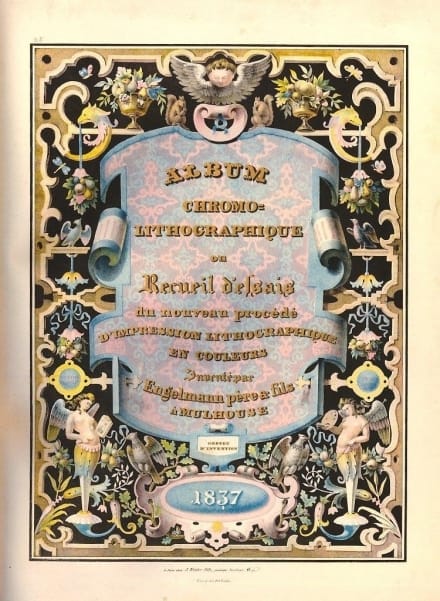
Godefroy Engelmann, Album chromolithographique ou Recueil d’essais du nouveau procédé d’impression lithographique en couleurs inventé par Engelmann père et fils, à Mulhouse, 1837. Frontespice. British Museum. Photo: British Museum.
Due to the state of lithographic printing technique and manufacturing of printing colours around 1840, printing houses usually used more than four stones for colour lithography. It was easier and cheaper to print colour lithographs from a greater number of stones. Engelmann had used crayon all over, but gradually it was replaced by ink and differing dotting techniques. You can say that the development of the print went from the primary elements dot, line and surface over the halftone cliché to the dot, now called pixels. The efforts of the lithographers to get halftone effects led to the halftone cliché in the end of the 19th century. And not before that time the trichromatic method became the norm. For colour lithography the use of many colour stones was the normal and time consuming procedure.
The abolishment of the trade guilds in 1846 made it easier for trade and industry in Sweden to develop, even if there still were restrictions. The need for commercial prints gave the printing trade a growing market. But even if only a few lithographic establishments had the capacity to print with colours, it was exceptions. Most lithographs, may it be pictures or commercial prints, were printed in black, sometime with one or two more colours. But slowly chromolithographs became more frequent. A. J. Salmson printed his first chromolithographs in 1847, followed by J. F. Meyer next year.
Chromolithographs were then sparsely printed in the 1850s and 1860s.
In 1841 the German lithographer Johann Friedrich Meyer started a lithographic establishment, J. F. Meyer & Co Litografiska Institut, that is lithographic institute. Its main business branch was commercial prints as tobacco or wine labels, business and visiting cards or bill forms.
In 1844 Axel Jakob Salmson established a lithographic establishment which would be a severe competitor to J. F. Meyer. Salmson had studied in the Royal Academy. After working in the workshop of Gjöthström & Magnusson he started at his own. Together with J. F. Meyer & Co. A. J. Salmson was the most successful lithographic establishment during the 1850s. Both firms used the latest technique and hired experienced specialists, often from Germany. Salmson opened a shop at the Bazaar on the Norrbro (The Northen Bridge) in front of the Royal Castle in Stockholm, here viewed by Carl Johan Billmark, at this time the most prominent Swedish artist working in lithography. As he could not find sufficiently good printers in Sweden he had early moved to Paris and printed his lithographs by Lemercier, one of the most important lithographic printing houses in Paris.
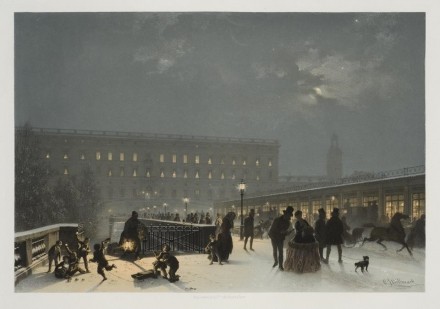
Carl Johan Billmark, Norrbro, 1867–69. Chromolithography, Lemercier, Paris. Nationalmuseum. 240×195 mm. Photo: Erik Cornelius, Nationalmuseum.
Salmson’s first album in chromolithography was The Hall of State at Gripsholm Castle. It consists of 28 plates, each one with a text and released in 14 parts between 1847 and 1851. The first part was printed in 1847 and thus the plates are probably the first images that have been printed as chromolithographs in Sweden.
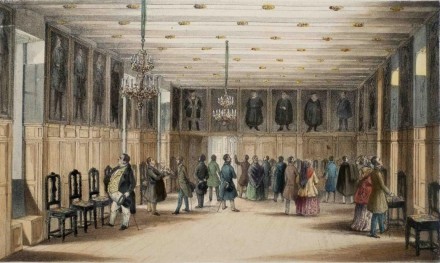
The Hall of State in Gripsholms Castle. In The State Hall in Gripsholms Castle. Historical Portrait Gallery of King
Gustaf’s Contemporary Regents in Lithochromie and Tinted Prints of A. J. Salmson, 1849-1851. Coloured chromolithography, partly varnished. Kungl. Biblioteket. Photo: Jan af Burén.
The first plate is a view of the castle and the second shows the Hall of State. The remaining plates show the portraits in the room. Two of the portraits have inscriptions which states that they were lithographed by Salmson himself, so there is every reason to think that he made all of them.
In the title Salmson used the term ”lithochromie”. This term was first used by Charles Louis Malapeau in 1823 in a small booklet where he described a technique to imitate oil painting lithographically on linen. The source where Salmson could have read the term was a German book with a long long name originally written by Heinrich Eduard Pescheck.[1] In 1843 it came in a second edition followed by at least 5 more editions during the 19th century. The author used the term lithochromie which here means the same as chromolithography.
In colour printing the order of the colours depends on the intention of the artist, Peschek wrote. He recommended to make the last printing with the black stone.
In the plate of the Hall of State the dresses of all the figures, the seats of the chairs, parts of the walls and most evident, the chandeliers, are hand coloured. On the coat of this gentleman you can see another feature of the early chromolithographs. To make a colour tone deeper it was coated with varnish. Here it is crackled. Meyer also used varnish in this way in his Chinese plates. The make up with hand painted colours is even recommended by Peschek for small parts, because it is easier and cheaper than preparing a new stone.[2]
Many lithographic establishments started magazines and Salmson started a very important periodical for the history of lithography in Sweden, the Lithografiskt Allehanda, (Lithographic Miscellaneous) with 12 numbers and 4 lithographs per annum between 1859 and 1865. It published lithographic reproductions of Swedish art and articles of general interest. The first numbers were the most ambitious with tinted lithographs in two or three colours and chromolithographs.
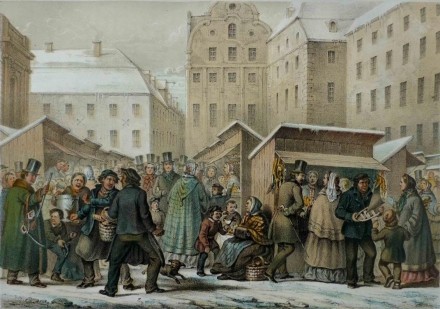
C. A. Dahlström, Christmas Market Stortorget in Stockholm. C. A. Dahlström del, Lith. o. tryckt hos Salmson,. Lithografiskt Allehanda 1859. 157 x 236 mm. National Library of Sweden. 298 x 425 mm. Photo: Jan af Burén.
The difference in quality between The Hall of State at Gripsholm and the lithographs in the Lithografiskt Allehanda is striking. The reason I think is that in 1857 Fredrik Nordmann was employed by Salmson. He was a German lithographer from Berlin where he had worked in the lithographic establishment of Winkelmann & Söhne directed by J. Storch, one of the leading German lithographic printers. The first colour lithograph was a view from the Christmas Market in the Old Town of Stockholm. The inventor was the artist Dahlström who probably also was the lithographer. In this plate every colour is printed. Six stones are used if my counting is correct.
J. F. Meyer returned to Germany in 1848 to learn the latest developments in the chromolithography. In Berlin he met J. Storch. Earlier Meyer had worked as an assistant to him. Now Meyer got his knowledge on chromolithography refreshed. Back home in Stockholm he immediately started to print with colours.
His first work was the illustrations to a book on China.
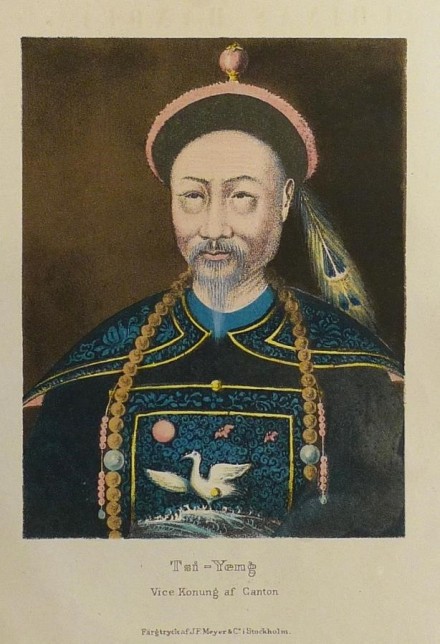
C. F. Liljevalch, The trade and industry of China, pl. 1, Tsi-Yeng, Vice King of Canton.. Colour print by J. F. Meyer & Co. i Stockholm. 220×135 mm. National Library of Sweden. Photo: Jan af Burén.
The businessman Carl Fredrik Liljevalch had been sent to China by the king to negotiate a treaty of commerce which was signed in 1847. At home he wrote the book about the trade and industry in China and got it illustrated with four chromolithographs.
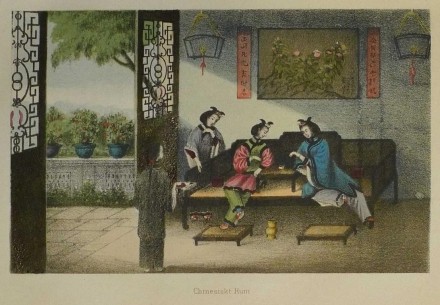
C. F. Liljewalch, The trade and industry of China, pl. 1, Tsi-Yeng, A Chinese room. Colour print by J. F. Meyer & Co i Stockholm. National Library of Sweden. 100×163 mm. Photo: Jan af Burén.
If you look attentively you can see that the plate has been ameliorated by hand. Look for instance at the lady in the center.
Johann Fredrik Meyer had called three brothers Schlachter to Stockholm in about 1844. In 1854 Hermann Seedorff came to Stockholm to work with Meyer. A few years later Salmson recruited all of them. But Salmson had invested too heavy in his business. To avoid a bankruptcy, he falsified signatures but was discovered. He escaped to USA in 1862. Hermann Seedorff had in the meantime married Salmson’s daughter Fredrika. Seedorff continued the business under the name “Former Salmson’s establishment”. After a while Seedorff started a new establishment together with Wilhelm Schlachter under the name Schlachter & Seedorff. Fredrik Nordmann who had worked with Salmson become instead a partner of J. F. Meyer & Co.
The early lithographic workshops in Sweden were all with few exceptions concentrated to Stockholm. In the middle of the 19th century new print shops were established in Malmö and Norrköping. In 1860 there were two lithographic printing houses in this town, Lithografiska Aktie Bolaget in Norrköping and Fredrik Törnequists Bok- och Stentryckeri. In the latter worked Fredrik Tilgmann. He was a German lithographer who came to Norrköping in 1857. Five years later he moved to Helsinki where he started a very successful printing house. In Norrköping he printed this poster for the establishment of Törnequist.
It is one of the first chromolithographs in Sweden printed with flat colours.
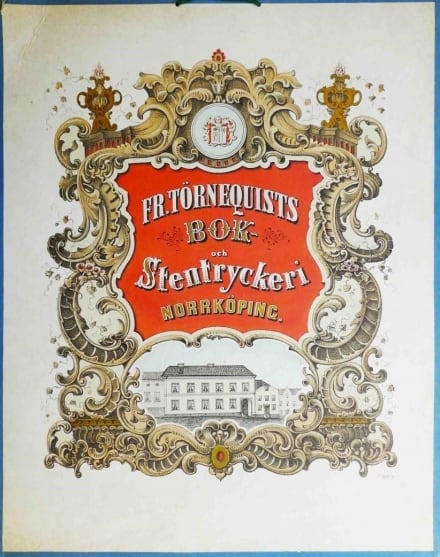
F. Tilgmann, Poster for Törnequist. Fr. Törnequist Bok- och Stentryckeri Norrköping. About 1860. Signed F. Tilgmann fec. National Library of Sweden. 598 x 477 mm. Photo: Jan af Burén.
But the most successful of the lithographic firms in Sweden started in the middle of the 19th century was Lithografiska Aktie Bolaget, ̶ i. e. Lithographic Inc. in Norrköping.
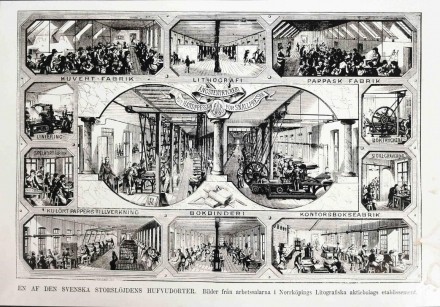
Business card from Lithografiska Aktie-Bolaget i Norrköping, (Lithographic Inc. in Norrköping). 1870-ies. Centre for Business History. Photo: Jan af Burén.
Norrköping is situated about 150 km south of Stockholm at the Baltic Sea. It was now the third town in Sweden and second to Stockholm as an industry town. Here Frithiof Åberg, 28 years old, started his lithographic printing house in 1858 with 30 persons employed. Two years later they had grown to 83 persons. Lithografiska, as it was called, dominated the lithographic scene in Sweden until the 1890-ies. During the first 10 years Åberg printed 9/10 of the total lithographic production in Sweden! In the 1880-ies the total had shrinked to only 50%.
In 1842 common and free elementary school was introduced in Sweden. The city of Norrköping which its big population of industrial workers considered education very important. Here the school inspector Fredrik Sandberg had started to make school posters by hand. Very early Åberg had understood that education was an important market. In the beginning of the 1860-ies Åberg printed a collection for the primary school which was hand coloured.
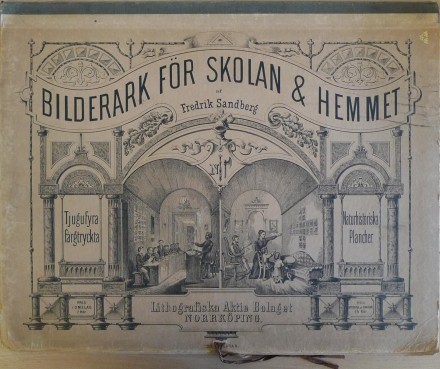
Fredrik Sandberg, Bilderark för Skolan och Hemmet, Cover. 2nd ed. About 1870. Lithografiska Aktie Bolaget i Norrköping. National Library of Sweden. 348×443 mm. Photo: Jan af Burén.
Evidently it was a success since he very soon printed a new edition, this time printed in colour. Both editions consisted of 25 plates. 11 of them were used in all the later editions. The plates showed animals, plants and geographic scenes.
The production of educational material became an important branch of the output and 1873 the Litografiska got a “Fortschrittmedaille” (medal of progress) at the World Exhibition in Wien for their educational material.
In 1844, the safety match was invented in Sweden by Gustaf Erik Pasch. It was the beginning of the match era in Jönköping and a little later in Tidaholm. Match labels became an important output of the lithographic printers. Many match factories started their own lithographic establishments. In 1884 there were three match factories in Jönköping and all three had a lithographic establishment of their own. Here are some examples from the collections of Litografiska Museet in Stockholm.
And a label to a toilet water printed by the Litografiska in Norrköping.
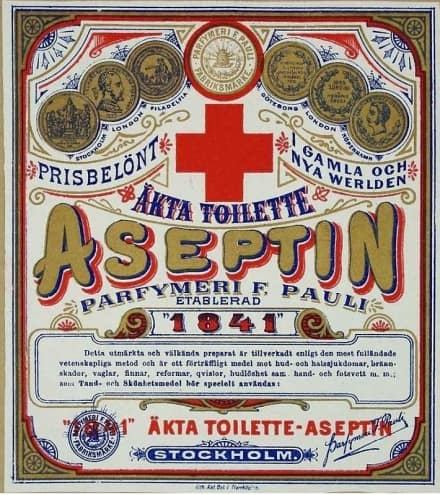
Label to an antiseptic toilet water. Lithografiska Aktiebolaget i Norrköping. 100 x 110 mm. Litografiska Museet. Photo: Jan af Burén.
Maps played an important role in the development of lithography and chromolithography. In Sweden, the army opened a lithographic office in 1833 run by an army officer, originally from Hannover. His name was Georg Leonard Dreyer. Maps was the primary product. They were drawn with the help of a pantograph by officers from the topographic corps and lithographed and printed by professional lithographers and printers. Here you can see an early example that is printed with colours.
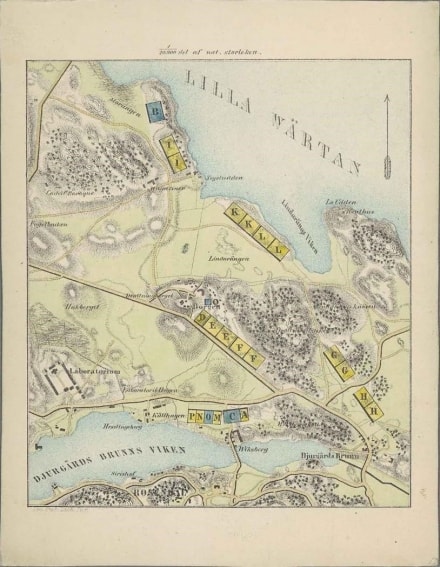
Map of the military excercise field at Stockholm, printed by Generalstabens Lithografiska Inrättning 1855. Chromolithography. 118×102 mm. Photo: Jonas Östman, National Library of Sweden.
I think it is printed with three stones, black, blue and yellow with the reservation that the squares are hand coloured.
In 1871 a young geological engineer, Algernon Börtzell, became interested in a new method of printing maps developed in Holland by the general at the topographic corps, J. A. Besier and C. A. Eckstein. Together with Wilhelm Schlachter, who had lithographed many maps, he was sent by the government to Besier and Eckstein in Haag 1872. The Besier-Eckstein method had three new elements compared with the traditional lithographic methods. First, the maps were copied to the stone with the help of a camera. Second, the letters were printed in a letter press and then transferred to the stone. The third and most revolutionizing element was that it was possible to render as many as 215 hues with only three stones. On a polished and etched stone, very fine lines were engraved with the help of a lining machine. Eight parallel and crossing lines were engraved per millimetre. Then the stone was etched with a solution containing nitric acid. The darker the desired colour was, the longer the stone was etched. Every primary colour could be printed in five different shades from light to dark.
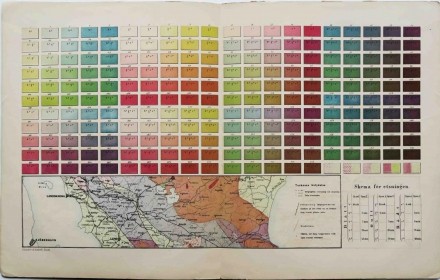
Wilhelm Schlachter, Colour samples and sample map in Desciption of chromolithography and linotypography used at the printing of the geologcial map of Skåne, Sveriges Geologiska Undersökning, Stockholm 1872. Schlachter & Seedorff. 300 x 475 mm. Litografiska Museet. Photo: Jan af Burén.
The method was said to be much easier and cheaper than the traditional methods. Back home Schlachter & Seedorff printed a geological map of Skåne. The result was very good, but it was never repeated, probably because the method was very work intensive with a very high demand of precision.
Later, in 1872, Börtzell took over the old military lithographic office, renamed it to Generalstabens Litografiska Anstalt The Lithographic Institute of the General Staff (GLA). Börtzell continued the tradition of the office to print maps, but he expanded the production to most products of a standard lithographic establishment. It is possible to follow the development of the establishment in detail, because all material is filed in a private archive. Börtzell was very “modern” and followed what happened in his time.
The localities were situated in a house that around 1800 was the workshop of the sculptor Johan Tobias Sergel. On the ground floor was an Otto gas machine and the Galvano plastic workshop. On the second floor were the office and the lithographic department. On the third floor the photo-chemigraphic department was located.
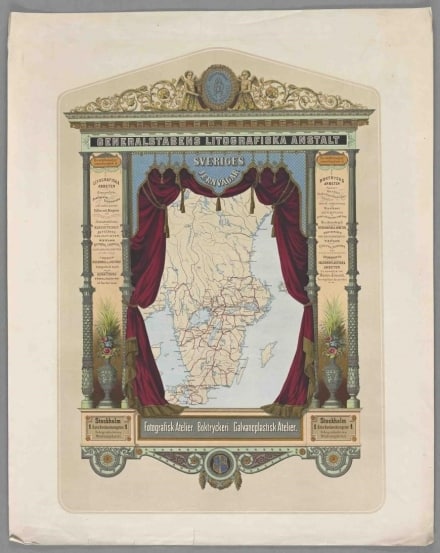
Poster for Generalstabens Litografiska Anstalt. 1880-1885. National Library of Sweden. 753 x 600 mm. Photo: Jonas Östman, National Library of Sweden.
In this poster Börtzell listed all the different branches of his establishment. The iconography is inspired of baroque printed portraits with swelling curtains, giving the depicted portrait or scene a theatrical character. This is here augmented by the tympanum on the top with the two angels holding a medallion with the trade mark of GLA. The columns alluding to Greek marble columns are here replaced by very modern columns made by cast iron. The poster is signalling modernity. The GLA soon became one of the leading lithographic establishments, especially in the photolithographic technique.
The lithographers Wilhelm Schlachter and Hermann Seedorff, who both had started their Swedish career at J. F. Meyer, started a lithographic establishment in the beginning of the 1870-ies.
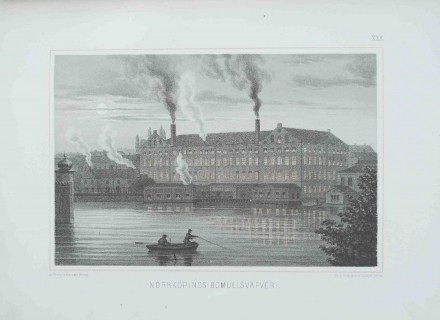
Gustaf Pabst, The Industrial Estalishments of Sweden. 1870-1879. 8th Part, pl. XXX, Cotton Mill at Norrköping. Schlachter & Seedorff, Stockh. 154×227 mm. National Library of Sweden. Photo: Jan af Burén.
This plate is taken from a series of views from Swedish industries released between 1872 and 1879. It is printed in 1874 by Schlachter & Seedorff. The same year this establishment was bought by the book printer A.L. Norman. Both
Wilhelm Schlachter and Hermann Seedorff continued to work at Norman’s. In 1874 the Centraltryckeriet AB, that is, the Central Printing Office Inc, was bought by Norman and Wilhelm Schlachter and Hermann Seedorff became directors of the lithographic department. I mention this because I am convinced that they contributed a very valuable lithographic knowledge and experience to Centraltryckeriet, which was to be the leading lithographic establishment in Sweden about 1890, stepping in the place of Lithografiska Aktie Bolaget in Norrköping.
The Swedish lithographers and lithographic printers were well-informed about news on colour printing. The sources were travelling lithographers and printers, the different commercial exhibitions, different manuals and magazines like Lithographia which started in 1861 in Hamburg. In the first number of Lithographia a series of articles started on the theme of “Lithographische Farbendruckbilder”, i. e. lithographic colour images. The first article starts with the words “Ein hässlisches Wort: Oelfarbendruck” A nasty word: oil colour print. The anonymous author, probably the editor Isermann, wanted to avoid this word, since he thought it was deceptive. The oil colour print tries to represent itself as an oil painting. But the lithographic technique cannot depict the saturated, strong character of the oil colour, nor its plasticity. With watercolours, it is completely different. Here lithography meets the water-colour. It is related to this through the rendering of colours, the material and the paper. So, it corresponds more the essence of the art of lithography, the author writes. I think that using water colour in the title is a way to make distance to the commercial chromolithography in the same way as etching was considered more original than the reproductive copper engraving.
The first time I have seen the expression “water-colour lithograph” used in Sweden, is in the title of an album by Carl Johan Billmark, who I mentioned earlier, Water-Colour Lithographs and Tinted Lithographs. Drawings after Nature. Interiors and Exteriors. Gripsholm, released 1853-1855. A later example is the album from 1884 by the artist Otto August Mankell printed by Centraltryckeriet.
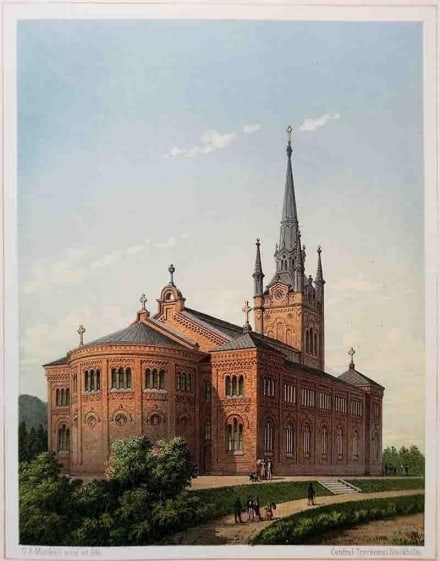
O. A. Mankell, St. Pauli Church, Gothenburg, in Göteborg, Aquarelle Litografier af O. A. Mankell, Centraltryckeriet 1884. 193 x 255 mm. Photo: Jan af Burén.
Mankell was born I Gothenburg 1838 and became an architect. As such he restored or built about 50 churches in Sweden. He is now most known for his lithographs from Stockholm, Gothenburg and Visby.
The first oleograph printed in Sweden was a reproduction after a painting by the king Charles XVth with a motive from Värmdö in the archipelago of Stockholm.[3]
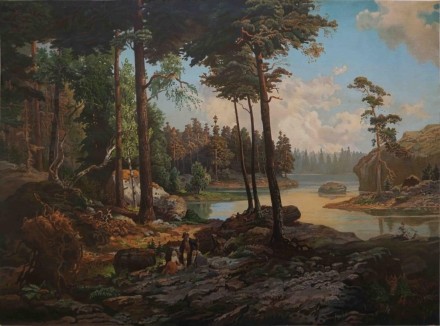
H. Weiss after King Charles XV, Landscape from Värmdö. Oleograph. Abr. Lundqvist & Co. 1866-68, 308×423 mm. Photo: Jan af Burén.
The painting was executed in 1865 and lithographed between 1866 and 1868 by Abraham Lundqvist & Co. A contemporary inscription on the mounting indicates that the artist was H. Weiss, a German lithographer. It is printed in at least eight colours. To the copy in the Royal Library a print from the black stone is preserved.
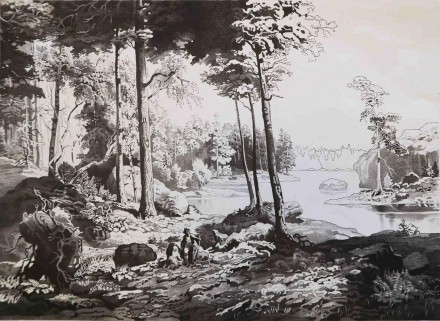
H. Weiss after King Charles XV, Landscape from Värmdö. Oleograph. Abr. Lundqvist & Co. 1866-68, 308 x 423 mm. Photo: Jan af Burén.
The oleograph is provided with a texture of canvas but not varnished. The production of oleographs ceased after some years. Oleographs were instead imported to Sweden, mostly from Germany.
The ephemera collection of the Royal Library in Stockholm is a veritable treasury. It contains legal deposits of material printed in Sweden. Here it is possible to follow the development of commercial prints during the 19th century, from very simple publicities printed in black to the magnificent publicities from the end of the century.
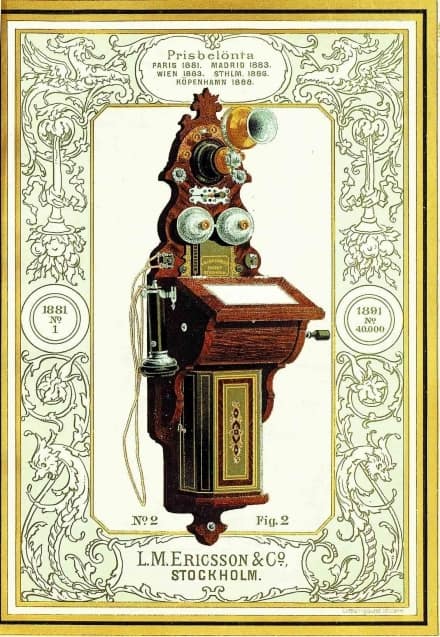
Cover to a price list from L. M. Ericsson & Co. 1892. Central-Tryckeriet Stockholm 1892. 241 x 168 mm. National Library of Sweden. Photo: Jonas Östman, Kungl Biblioteket.
This cover of a price list from the telephone company L. M. Ericson was for a long time my favorite with its trompe l’oeil character borrowed from the Dutch still lifes of the 17th century. As a publicity, it is very effective with its precise details, showing one of the most modern commodity at that time.
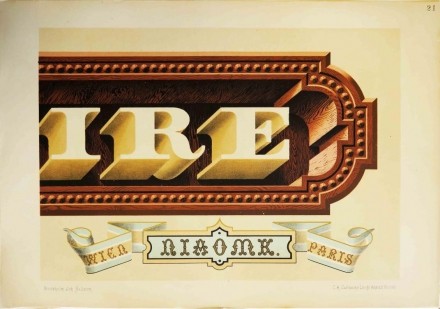
Frithiof Telenius, Skyltmotiv af Frithiof Telenius Skyltmålare i Stockholm. 30 plancher i färgtryck, pl 21. Stockholm.
Publisher Joh. Hellsten (Book shop 1884) , printer C. A. Carlssons Litogr. Anstalt, Stockholm. 300×426 mm. National Library of Sweden. Photo: Jan af Burén.
By chance I found images of the Swedish sign painter Gustaf Frithiof Telenius at an American university site. Next day I sat in the special reading room in the Royal Library and looked on these marvelous lithographs, made by the lithographer and printer Carl Adolf Carlsson, borned in Stockholm 1850. He is mentioned in the population register in Stockholm 1869 as an apprentice of lithography. Some years later he had advanced to be a lithographic worker. My guess is that Carlsson started his apprenticeship at Schlachter & Seedorff and then followed them to Centraltryckeriet. After some years, abroad in Paris, Wien and Berlin he went back to Stockholm. About 1880 he started his own lithographic firm.
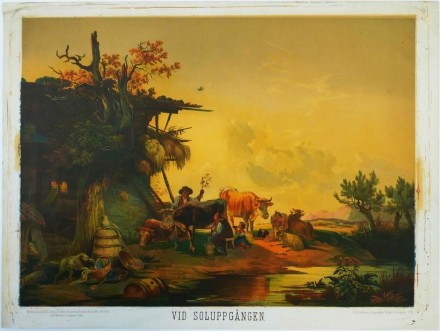
At the sunrise. Supplement to the magazine Lördags-Quällen, (The Saturday Evening), printed at C. A. Carlsson Litografiska Tryckeri, Stockholm 1881. 457 x 670 mm. National Library of Sweden. Photo: Jan af Burén.
In 1881 the magazine Lördaqs-Qvällen (The Saturday Evening) published a chromolithography, At the Sunrise. This copy has its registration marks. It is printed so far I can see with the colours yellow, blue and red.
Carlsson also begun to reproduce paintings by Nordic artists in the collections of Nationalmuseum, The Swedish national museum of fine arts. There had been many reproductions of the collections of the Nationalmuseum in different graphic techniques, but these were the first ones in chromolithography printed in Sweden.
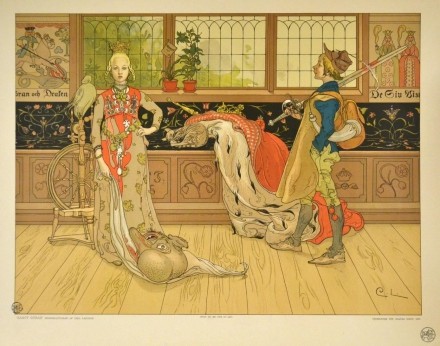
Carl Larsson, St. George and the Princess. Generalstabens Litografiska Anstalt 1896, 8 stones. 474×627 mm. Föreningen för Grafisk Konst. Photo: Lisa Larsson Sundling.
Here you may wonder why I have not mentioned the artists. The reason is that the art of lithography, and specially chromolithography, mostly was neglected by the artists. And not only by the artists. When the Swedish newspaper Svenska Dagbladet wrote about the centennial exhibition of lithography in Paris in 1895, chromolithography was only considered as a reproductive medium. In Sweden, the first chromolithography made by an artist was this one by Carl Larsson, released by The Association of Graphic Arts in 1896 and printed by the Generalstabens Litografiska Anstalt.
This was a very brief history of the Swedish chromolithography during the 19th century. It is a fascinating field of history since it contains both the more technical printing history and art history, because the form is a very important part of printing. You can call it technical art history if you want. The period started with chromolithographs augmented with painted colours in a rather restricted graphic milieu of etching, engraving and black lithographs and ended in what can be called a graphic universe with a nearly endless number of graphic techniques.
[1] Heinrich Eduard Pescheck; Leo Bergmann, Das Ganze des Steindrucks; oder, Vollstä ndige theoretischpraktische Anweisung zur Ausü bung der Lithographie in ihrem ganzen Umfange und aufihrem jetzigen Standpunkte; Anleitung zur Anfertigung von Steinzeichnungen nach allen gebrä uchlichen Manieren, zur Lithochromie oder dem Farbendrucke und zu allen sonstigen lithographischen Operationen; Beschreibung aller Apparate und Gerä thschaften zum Steindrucke &c. Nebst einem Anhange von der Zinkographie, Weimar 1843
[2] Ds. p. 166
[3] Medföljde tidskriften Förr och nu: illustrerad läsning för hemmet som premiebilaga för prenumeranter 1871

